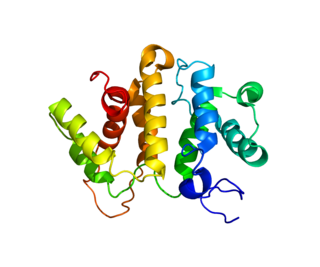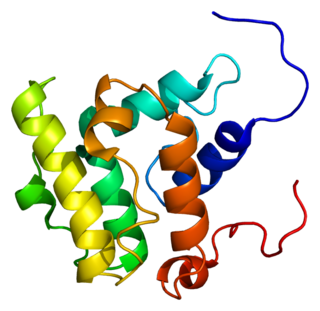Related Research Articles

Neural crest cells are a temporary group of cells unique to vertebrates that arise from the embryonic ectoderm germ layer, and in turn give rise to a diverse cell lineage—including melanocytes, craniofacial cartilage and bone, smooth muscle, peripheral and enteric neurons and glia.
The Rho family of GTPases is a family of small signaling G proteins, and is a subfamily of the Ras superfamily. The members of the Rho GTPase family have been shown to regulate many aspects of intracellular actin dynamics, and are found in all eukaryotic kingdoms, including yeasts and some plants. Three members of the family have been studied in detail: Cdc42, Rac1, and RhoA. All G proteins are "molecular switches", and Rho proteins play a role in organelle development, cytoskeletal dynamics, cell movement, and other common cellular functions.

Cell division control protein 42 homolog, also known as Cdc42, is a protein involved in regulation of the cell cycle. It was originally identified in S. cerevisiae (yeast) as a mediator of cell division, and is now known to influence a variety of signaling events and cellular processes in a variety of organisms from yeast to mammals.

FYVE, RhoGEF and PH domain-containing protein 1 (FGD1) also known as faciogenital dysplasia 1 protein (FGDY), zinc finger FYVE domain-containing protein 3 (ZFYVE3), or Rho/Rac guanine nucleotide exchange factor FGD1 is a protein that in humans is encoded by the FGD1 gene that lies on the X chromosome. Orthologs of the FGD1 gene are found in dog, cow, mouse, rat, and zebrafish, and also budding yeast and C. elegans. It is a member of the FYVE, RhoGEF and PH domain containing family.

Transforming protein RhoA, also known as Ras homolog family member A (RhoA), is a small GTPase protein in the Rho family of GTPases that in humans is encoded by the RHOA gene. While the effects of RhoA activity are not all well known, it is primarily associated with cytoskeleton regulation, mostly actin stress fibers formation and actomyosin contractility. It acts upon several effectors. Among them, ROCK1 and DIAPH1 are the best described. RhoA, and the other Rho GTPases, are part of a larger family of related proteins known as the Ras superfamily, a family of proteins involved in the regulation and timing of cell division. RhoA is one of the oldest Rho GTPases, with homologues present in the genomes since 1.5 billion years. As a consequence, RhoA is somehow involved in many cellular processes which emerged throughout evolution. RhoA specifically is regarded as a prominent regulatory factor in other functions such as the regulation of cytoskeletal dynamics, transcription, cell cycle progression and cell transformation.

Rab GDP dissociation inhibitor alpha is a protein that in humans is encoded by the GDI1 gene.

Rho GTPase-activating protein 1 is an enzyme that in humans is encoded by the ARHGAP1 gene.

Ras GTPase-activating-like protein IQGAP1 (IQGAP1) also known as p195 is a ubiquitously expressed protein that in humans is encoded by the IQGAP1 gene. IQGAP1 is a scaffold protein involved in regulating various cellular processes ranging from organization of the actin cytoskeleton, transcription, and cellular adhesion to regulating the cell cycle.

Cdc42-interacting protein 4 is a protein that in humans is encoded by the TRIP10 gene.

Rho-related GTP-binding protein RhoQ is a protein that in humans is encoded by the RHOQ gene.

RhoG is a small monomeric GTP-binding protein, and is an important component of many intracellular signalling pathways. It is a member of the Rac subfamily of the Rho family of small G proteins and is encoded by the gene RHOG.

Rho GTPase-activating protein 5 is an enzyme that in humans is encoded by the ARHGAP5 gene.

Rnd2 is a small signaling G protein, and is a member of the Rnd subgroup of the Rho family of GTPases. It is encoded by the gene RND2.

Guanine nucleotide exchange factor VAV3 is a protein that in humans is encoded by the VAV3 gene.

Cdc42 effector protein 1 is a protein that in humans is encoded by the CDC42EP1 gene.

Rho GTPase-activating protein 32 is a protein that in humans is encoded by the RICS gene. RICS has two known isoforms, RICS that are expressed primarily at neurite growth cones, and at the post synaptic membranes, and PX-RICS which is more widely expressed in the endoplasmic reticulum, Golgi apparatus and endosomes. The only known domain of the RICS is the RhoGAP domain, whilst PX-RICS has an additional Phox homology and SH3 domain.

Rap guanine nucleotide exchange factor 2 is a protein that in humans is encoded by the RAPGEF2 gene.
TCL is a small signaling G protein, and is a member of the Rho family of GTPases.,.
Rif is a small signaling G protein, and is a member of the Rho family of GTPases. It is primarily active in the brain and plays a physiological role in the formation of neuronal dendritic spine. This process is regulated by FARP1, a type of activator for RhoA GTPases. Alternatively, Rif can induce the formation of actin stress fibers in epithelial cells, which is dependent on the activity levels of ROCK proteins since the absence of ROCK activity would mean Rif would be unable to stimulate the growth of stress fibers.
RhoU is a small signaling G protein, and is a member of the Rho family of GTPases. Wrch1 was identified in 2001 as encoded by a non-canonical Wnt induced gene. RhoU/Wrch delineates with RhoV/Chp a Rho subclass related to Rac and Cdc42, which emerged in early multicellular organisms during evolution.
References
- ↑ Aronheim A, Broder YC, Cohen A, Fritsch A, Belisle B, Abo A (1998). "Chp, a homologue of the GTPase Cdc42Hs, activates the JNK pathway and is implicated in reorganizing the actin cytoskeleton". Curr Biol. 8 (20): 1125–8. doi: 10.1016/S0960-9822(98)70468-3 . ISSN 0960-9822. PMID 9778532.
- ↑ Boureux A, Vignal E, Faure S, Fort P (2007). "Evolution of the Rho family of ras-like GTPases in eukaryotes". Mol. Biol. Evol. 24 (1): 203–16. doi:10.1093/molbev/msl145. PMC 2665304 . PMID 17035353.
- ↑ Chenette EJ, Mitin NY, Der CJ (2006). "Multiple Sequence Elements Facilitate Chp Rho GTPase Subcellular Location, Membrane Association, and Transforming Activity". Mol Biol Cell. 17 (7): 3108–21. doi:10.1091/mbc.E05-09-0896. ISSN 1059-1524. PMC 1483044 . PMID 16641371.
- ↑ Guemar L, de Santa Barbara P, Vignal E, Maurel B, Fort P, Faure S (2007). "The small GTPase RhoV is an essential regulator of neural crest induction in Xenopus". Dev Biol. 310 (1): 113–28. doi: 10.1016/j.ydbio.2007.07.031 . ISSN 0012-1606. PMID 17761159.